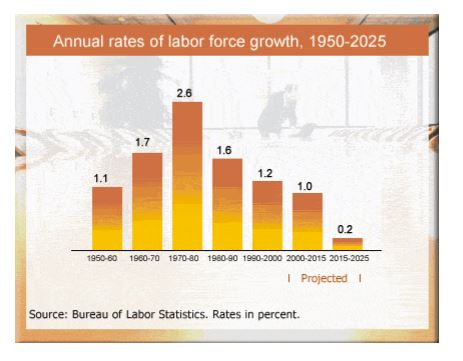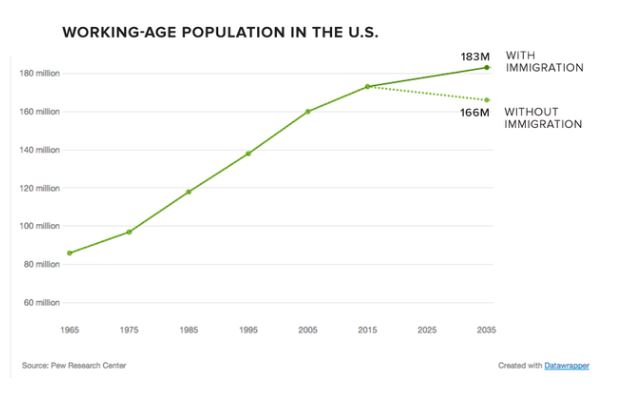Trump Probably Doesn’t Get The Demographics Of Immigration
“For most of the past half-century, adults in the U.S. Baby Boom generation – those born after World War II and before 1965 – have been the main driver of the nation’s expanding workforce. But as this large generation heads into retirement, the increase in the potential labor force will slow markedly, and immigrants will play the primary role in the future growth of the working-age population (though they will remain a minority of it).” (Jeffrey Passel and D’Vera Cohn, Immigration projected to drive growth in U.S. working-age population through at least 2035, Pew Research, March 8, 2017)
As the following chart indicates, during the 1970s the U.S. experienced a very rapid growth in its labour force. The rapid labour force growth in the 1970s reflected two dramatic changes: the baby-boom generation reached working age and an increase in women working outside their homes.
However, since the 1970s, the labour force has continued to expand, but at ever slower growth rates. Indeed, BLS projections suggest a substantial slowdown in the annual growth pace of labour force for the 2015-25 period due to the baby-boom generation retiring and leaving the work force.
The labor force is projected to grow over the next 10 years at an average annual rate of about 0.2%, far slower than in recent decades. Aside from the continued aging of the U.S. population, the labor force labor force participation rate is also projected to decline over the projection period.

Projections provided by Pew Research highlight the importance of immigration in supporting the growth of working-age population in the U.S.Indeed, without any new immigrants, by 2015 the working age population group which supports the U.S. economy would shrink back to 2005 levels.
The Pew Research Center report indicates that the U.S. working-age population (people aged 25-64), which was 173.2 million in 2015, will shrink to 165.6 million by 2035 without immigrants entering the country. At current rates of immigration, by contrast, the worker pool would expand to 183.2 million.
In fact, the only way for the U.S. labor force to grow over the next two decades is for new immigrants to replace retiring baby boomers.

Disclosure: None.




So much for recovery, unless the people who have totally given up on work will all decide to work after years of losing skills to do much of anything. Trump's growth plan is highly exaggerated, prof.
@[Gary Anderson](user:4798), you are right that #Trump's plan is exagerated. But the #Democrats have spent years not only enabling those who don't want to work, but actually encouraging them not to. Many are better off getting a free ride than actually working for a living. At least those making less than about $60k per year or so.
No, the Great recession was used by the Fed to cut back wages. Don't blame the Democrats for failure of corporations to pay a living wage. That thinking is Libertarian gibberish.
Sadly, Americans who have been around the last 30 years have watched their standard of living go out the window. We should care more about this than economic growth premised on a rising population, especially when it leads to a drop in the standard of living. As for labor issues, technology is working hard and fast to replace jobs not just with robots but with ever increasing efficiency which is why big companies are richer than ever.
Yes, it's very sad that the American Dream has devolved so greatly. Instead of owning a home with a white picket fence, I often think the best my grandkids can hope for is a job at McDonalds with no benefits and a lifetime of student loands and debt.